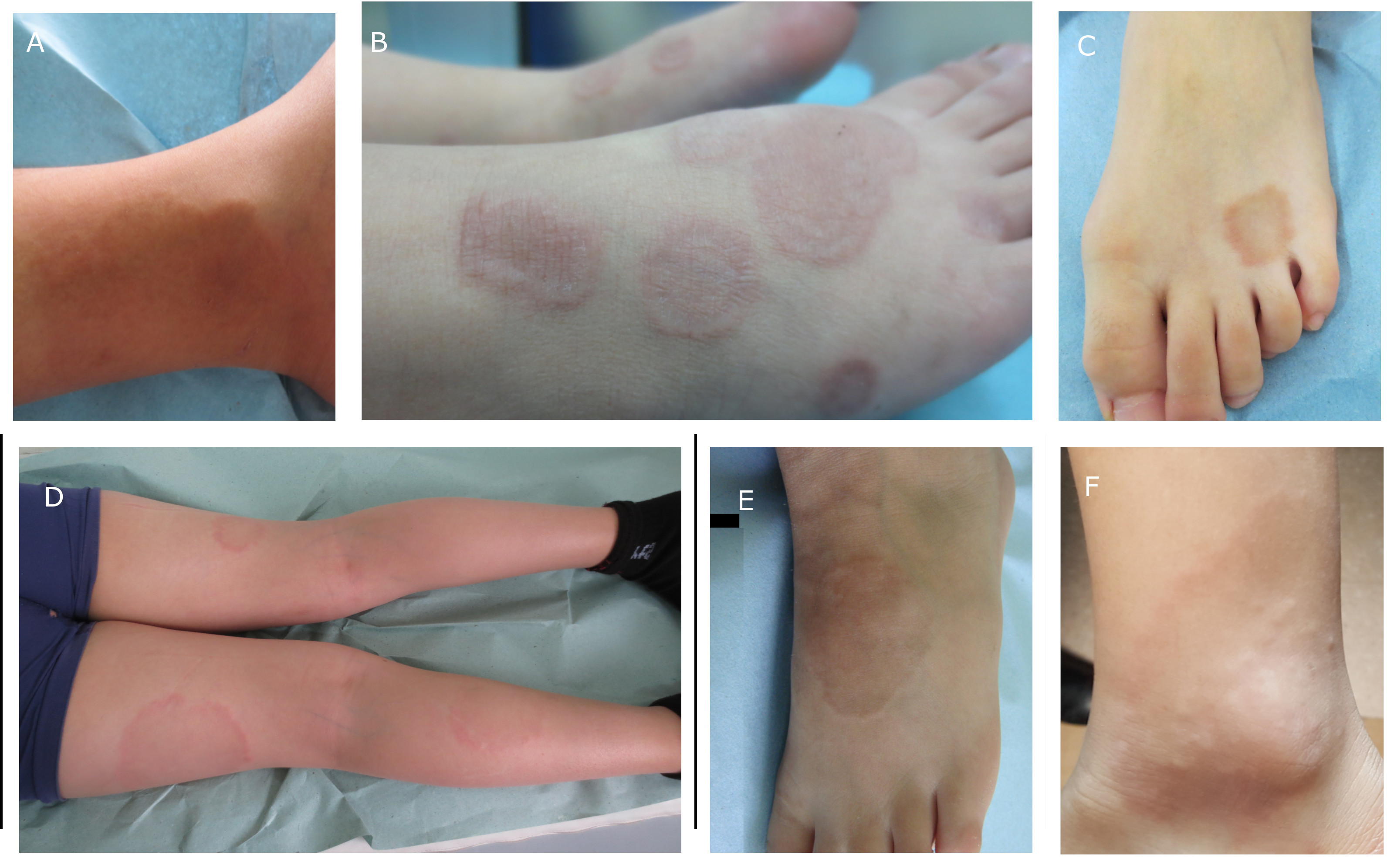Chilhood granuloma annulare: Case series
Main Article Content
Abstract
Background: Granuloma annulare (GA) is a relatively common benign inflammatory disorder of unknown etiology, often self-limited, affecting children and adults. The condition is characterized by several clinical forms of presentation, the most common being an annular plaque, with a marked border, erythematous, and without scales, predominating in the distal extremities. Treatment is indicated for patients who have symptomatic lesions. Case report: this article presents a series of 9 cases of GA in pediatric age. Conclusions: GA is a benign inflammatory disease of unknown origin, with associations that have not yet been confirmed; it occurs in children and adults and has different morphologies, the most frequent being the annular, erythematous, and scaleless.
Downloads
Article Details

This work is licensed under a Creative Commons Attribution-NonCommercial-NoDerivatives 4.0 International License.
Creative Commons
License Attribution-NonCommercial-ShareAlike 4.0 International (CC BY-NC-SA 4.0)
You are free to:
Share - copy and redistribute the material in any medium or format.
Adapt - remix, transform, and build upon the material The licensor cannot revoke these freedoms as long as you follow the license terms.
• Attribution — You must give appropriate credit, provide a link to the license, and indicate if changes were made. You may do so in any reasonable manner, but not in any way that suggests the licensor endorses you or your use.
• NonCommercial — You may not use the material for commercial purposes.
• ShareAlike — If you remix, transform, or build upon the material, you must distribute your contributions under the same license as the original.
• No additional restrictions — You may not apply legal terms or technological measures that legally restrict others from doing anything the license permits.
References
Muhlbauer JE. Granuloma annulare. J Am Acad Dermatol. septiembre de 1980;3(3):217-30. DOI: https://doi.org/10.1016/S0190-9622(80)80181-2
Piette EW, Rosenbach M. Granuloma annulare: Clinical and histologic variants, epidemiology, and genetics. J Am Acad Dermatol. 2016;75(3):457-65. DOI: https://doi.org/10.1016/j.jaad.2015.03.054
Piette EW, Rosenbach M. Granuloma annulare: Pathogenesis, disease associations and triggers, and therapeutic options. J Am Acad Dermatol. 2016;75(3):467-79. DOI: https://doi.org/10.1016/j.jaad.2015.03.055
Vera Casaño Á. Granuloma anular en la infancia. Piel. 2007;22(4):181-5. DOI: https://doi.org/10.1016/S0213-9251(07)73046-0
Kakourou T, Psychou F, Voutetakis A, Xaidara A, Stefanaki K, Dacou-Voutetakis C. Low serum insulin values in children with multiple lesions of granuloma annulare: a prospective study. J Eur Acad Dermatol Venereol. 2005;19(1):30-4. DOI: https://doi.org/10.1111/j.1468-3083.2004.01078.x
Moran J, Lamb J. Localized granuloma annulare and autoimmune thyroid disease. Are they associated? Can Fam Physician. 1995;41:2143-4.
Maschio M, Marigliano M, Sabbion A, Morandi A, Schena D, Colato C, et al. A rare case of granuloma annulare in a 5-year-old child with type 1 diabetes and autoimmune thyroiditis. Am J Dermatopathol. 2013;35(3):385-7. DOI: https://doi.org/10.1097/DAD.0b013e318272f6c6
Davison JE, Davies A, Moss C, Kirk JMW, Taibjee SM, Chizo Agwu J. Links Between Granuloma Annulare, Necrobiosis Lipoidica Diabeticorum and Childhood Diabetes: A Matter of Time? Ped dermatol. 2010;27(2):178-81. DOI: https://doi.org/10.1111/j.1525-1470.2010.01099.x
Yun JH, Lee JY, Kim MK, Seo YJ, Kim MH, Cho KH, et al. Clinical and pathological features of generalized granuloma annulare with their correlation: a retrospective multicenter study in Korea. Ann Dermatol. 2009;21(2):113-9. DOI: https://doi.org/10.5021/ad.2009.21.2.113
Requena L, Fernández-Figueras MT. Subcutaneous granuloma annulare. Semin Cutan Med Surg. 2007;26(2):96-9. DOI: https://doi.org/10.1016/j.sder.2007.02.006
Gomez-Moyano E, Vera-Casaño A, Martinez S, Sanz A. Periorbital granuloma annulare successfully treated with tacrolimus 0.1% ointment. Int J Dermatol. 2014;53(2):e156-157. DOI: https://doi.org/10.1111/j.1365-4632.2012.05499.x
Blume-Peytavi U, Zouboulis CC, Jacobi H, Scholz A, Bisson S, Orfanos CE. Successful outcome of cryosurgery in patients with granuloma annulare. Br J Dermatol. 1994;130(4):494-7. DOI: https://doi.org/10.1111/j.1365-2133.1994.tb03384.x
Kuwahara RT, Naylor MF, Skinner RB. Treatment of granuloma annulare with topical 5% imiquimod cream. Pediatr Dermatol. 2003;20(1):90. DOI: https://doi.org/10.1046/j.1525-1470.2003.30234.x
Chia G, Ahmed L, Oligbu P, Odeigah L, Oligbu G. Are antibiotics of any use in the management of granuloma annulare in children? Afr J Infect Dis. 2019;13(2):1-12. DOI: https://doi.org/10.21010/ajid.v13i2.1
S. WELLS R, Smith M. The Natural History of Granuloma Annulare. British Journal of Dermatology. 2006;75:199-205. DOI: https://doi.org/10.1111/j.1365-2133.1963.tb13549.x





